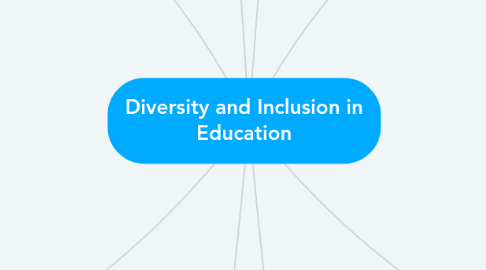Diversity and Inclusion in Education
by Genevieve Baxa

1. Definition of Diversity Acceptance
1.1. It is the recognizing that people are different, and each other's uniqueness can bring about a deeper appreciation of the global world, foster respect, and will allow students to understand and value other people's perspectives.
1.2. Students and staff are provided with equal opportunities, regardless of their heritage, color, gender, socioeconomic status, and abilities.
2. Characteristics of a Diverse and Inclusive Learning Environments
2.1. Students can freely explore and learn new concepts, and that they feel safe to express their own ideas.
2.2. Students can feel a sense of belongingness in the community of learners.
2.3. The primary stakeholders (teachers, parents, administration) cooperate and promote collaborative teaching arrangements (McLeskey & Waldron, 2000).
2.4. The physical space of the school and classroom support the individual needs of the students.
2.4.1. Desks are arranged in groups to promote social interaction
2.4.2. There are provisions and facilities available for students with physical disabilities.
2.5. School materials and instructional strategies are age and developmentally-appropriate.
2.6. There is representation of racial diversity among school administration and the community of learners (Castro et.al., 2018).
3. Instructional Strategies to Promote Diversity and Inclusion in the Classroom
3.1. Encourage peer-learning in classrooms by intentionally grouping learners to help with the transition of the students (Hill, 2017).
3.2. Differentiated instruction should be done to accommodate various learning styles.
3.3. The use of assistive technology for learners with special needs should be maximized (Eredics, n.d.).
3.4. Collaborate with professionals from the field of special education to come up with an IEP that would work well in an inclusive classroom.
3.5. Using visual aids, and other concrete materials will support students' learning.
3.6. Discussions on different cultural practices and celebrations should be done in class to recognize and promote diversity.
4. Criticisms of Inclusive Education
4.1. There is a need for general education teachers to undergo professional development training to better address the needs of students with special needs (Anderson et.al., 2018)
4.2. An inclusive curriculum is not being implemented in schools-- the emphasis given to high-stakes testing is still big, rather than opportunities for students to achieve equity in education.
4.3. School facilities can be inaccessible to students with special needs and inadequacy of learning materials and other resources should also be addressed.
5. Definition of Inclusion
5.1. Inclusion is making high-quality education equally accessible to students with special needs alongside their typically developing peers.
5.2. It is providing the necessary educational support and intervention for students who are challenged to aid in their learning and enhance their performance in the classroom.
6. Role of Teachers, Parents, and Peers
6.1. Teachers' behavior towards students greatly impacts how students behave towards their peers (Avcioglu, 2017).
6.2. Teachers should recognize barriers to learning and address individual differences, and the different learning styles of students.
6.3. Teachers should create and nurture positive learning environments where students will feel safe and comfortable to express their views and ideas.
6.4. Teachers, parents, and other stakeholders should actively communicate and collaborate to set goals and make effective interventions to increase the child's learning outcomes.
6.5. Peers should respect and appreciate individual differences by avoiding stereotypes and making an effort to support each other's learning.
7. Benefits of Diversity and Inclusion in the Classroom
7.1. Diversity in classrooms improves academic outcomes.
7.2. Diversity in skills and abilities enhance the value of team efforts (Mwangi, 2012).
7.3. Acceptance and respect for others is fostered in the community. There is no isolation regardless of the differences in color, race, gender, and ability.
7.4. Inclusive practices make effective use of the school's resources (Inclusive Schools Network, 2015).
8. Legislations and Policies that Support Diversity and Inclusion in Education
8.1. Individuals with Disabilities Education Act (IDEA) is a law in the United States that makes free and appropriate education and special education services available for students with disabilities (IDEA, 2004).
8.2. The Convention on the Rights of the Child (CRC) and Convention on the Rights of Persons with Disabilities (CRPD) provides provisions for a rights-based approach to inclusive education (UNICEF, 2014).
8.3. Scholarships and Financial Aids are given to low-income and marginalized families to provide equitable opportunities and access to education.


